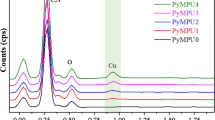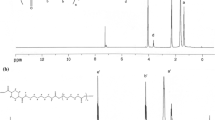Abstract
In this work, we synthesized two kinds of polyurethanes with azobenzene as hard segments in the side chains and in the main chains. Their thermal stabilities were high enough for their shape memory application. For polyurethane with azobenzene in the side chain (PU), the azobenzene has more distinctly effect on inhibiting crystallization of polycaprolactone (PCL) because of irregular orientation of azobenzene. For polyurethane with azobenzene in the main chain (PUR), the crystallinity of PCL is mainly affected by its molecular weight. PU-3500 and PUR-3500 exhibit perfect shape fixing ability of 99 % with recovery ratio of 98 % at 50 % strain. The recovery ratio is decreased for PU-3500 and increased for PUR-3500 as the applied strain increased. The mechanism of the hard segment structures effect on the shape memory behavior is briefly discussed. Importantly, the two molecules behave trans–cis isomerization under UV irradiation. This work is crucially important for the structural design of shape memory polyurethane and applications in the smart devices.
Graphical Abstract











Similar content being viewed by others
References
Habault D, Zhang H, Zhao Y (2013) Light-triggered self-healing and shape-memory polymers. Chem Soc Rev 42:7244–7256. doi:10.1039/c3cs35489j
Lendlein A, Kelch S (2002) Shape-memory polymers. Angew Chem Int Ed 41:2034–2057. doi:10.1002/1521-3773(20020617)41:12<2034:AID-ANIE2034>3.0.CO;2-M
Liu C, Qin H, Mather PT (2007) Review of progress in shape-memory polymers. J Mater Chem 17:1543–1558. doi:10.1039/B615954K
Wang Z, Zhao J, Chen M et al (2014) Dually actuated triple shape memory polymers of cross-linked polycyclooctene–carbon nanotube/polyethylene nanocomposites. ACS Appl Mater Interfaces 6:20051–20059. doi:10.1021/am5056307
Meng Q, Hu J (2009) A review of shape memory polymer composites and blends. Compos A Appl Sci Manuf 40:1661–1672. doi:10.1016/j.compositesa.2009.08.011
Bonanno LM, DeLouise LA (2010) Integration of a chemical-responsive hydrogel into a porous silicon photonic sensor for visual colorimetric readout. Adv Funct Mater 20:573–578. doi:10.1002/adfm.200901694
Yu C, Duan Z, Yuan P et al (2013) Electronically programmable, reversible shape change in two- and three-dimensional hydrogel structures. Adv Mater 25:1541–1546. doi:10.1002/adma.201204180
Lendlein A, Langer R (2002) Biodegradable, elastic shape-memory polymers for potential biomedical applications. Science 296:1673–1676. doi:10.1126/science.1066102
Zheng X, Zhou S, Li X, Weng J (2006) Shape memory properties of poly(d, l-lactide)/hydroxyapatite composites. Biomaterials 27:4288–4295. doi:10.1016/j.biomaterials.2006.03.043
Shi Y, Yoonessi M, Weiss RA (2013) High temperature shape memory polymers. Macromolecules 46:4160–4167. doi:10.1021/ma302670p
Ahn S-K, Kasi RM (2011) Exploiting microphase-separated morphologies of side-chain liquid crystalline polymer networks for triple shape memory properties. Adv Funct Mater 21:4543–4549. doi:10.1002/adfm.201101369
Cuevas JM, Rubio R, German L et al (2012) Triple-shape memory effect of covalently crosslinked polyalkenamer based semicrystalline polymer blends. Soft Matter 8:4928–4935. doi:10.1039/C2SM07481H
Bothe M, Mya KY, Jie Lin EM et al (2012) Triple-shape properties of star-shaped POSS-polycaprolactone polyurethane networks. Soft Matter 8:965–972. doi:10.1039/C1SM06474F
Jang MK, Hartwig A, Kim BK (2009) Shape memory polyurethanes cross-linked by surface modified silica particles. J Mater Chem 19:1166–1172. doi:10.1039/B816691A
Alteheld A, Feng Y, Kelch S, Lendlein A (2005) Biodegradable, amorphous copolyester-urethane networks having shape-memory properties. Angew Chem Int Ed 44:1188–1192. doi:10.1002/anie.200461360
Lendlein A, Zotzmann J, Feng Y, Alteheld A, Kelch S (2009) Controlling the switching temperature of biodegradable, amorphous, shape-memory poly(rac-lactide)urethane networks by incorporation of different comonomers. Biomacromolecules 10:975–982. doi:10.1021/bm900038e
Sun H, Mei L, Song C, Cui X, Wang P (2006) The in vivo degradation, absorption and excretion of PCL-based implant. Biomaterials 27:1735–1740. doi:10.1016/j.biomaterials.2005.09.019
Momtaz M, Razavi-Nouri M, Barikani M (2014) Effect of block ratio and strain amplitude on thermal, structural, and shape memory properties of segmented polycaprolactone-based polyurethanes. J Mater Sci 49:7575–7584. doi:10.1007/s10853-014-8466-y
Behl M, Ridder U, Feng Y, Kelch S, Lendlein A (2009) Shape-memory capability of binary multiblock copolymer blends with hard and switching domains provided by different components. Soft Matter 5:676–684. doi:10.1039/B810583A
Lee BS, Chun BC, Chung Y-C, Sul KI, Cho JW (2001) Structure and thermomechanical properties of polyurethane block copolymers with shape memory effect. Macromolecules 34:6431–6437. doi:10.1021/ma001842l
Wang S, Lu L, Gruetzmacher JA, Currier BL, Yaszemski MJ (2006) Synthesis and characterizations of biodegradable and crosslinkable poly(ε-caprolactone fumarate), poly(ethylene glycol fumarate), and their amphiphilic copolymer. Biomaterials 27:832–841. doi:10.1016/j.biomaterials.2005.07.013
Huang WM, Zhao Y, Wang CC et al (2012) Thermo/chemo-responsive shape memory effect in polymers: a sketch of working mechanisms, fundamentals and optimization. J Polym Res 19:1–34. doi:10.1007/s10965-012-9952-z
Behl M, Razzaq MY, Lendlein A (2010) Multifunctional shape-memory polymers. Adv Mater 22:3388–3410. doi:10.1002/adma.200904447
Natansohn A, Rochon P (2002) Photoinduced motions in azo-containing polymers. Chem Rev 102:4139–4175
Chen W, Wei X, Balazs AC, Matyjaszewski K, Russell TP (2011) Phase behavior and photoresponse of azobenzene-containing polystyrene-block-poly(n-butyl methacrylate) block copolymers. Macromolecules 44:1125–1131. doi:10.1021/ma101982u
Wu Y, Natansohn A, Rochon P (2004) Photoinduced birefringence and surface relief gratings in polyurethane elastomers with azobenzene chromophore in the hard segment. Macromolecules 37:6090–6095. doi:10.1021/ma0493980
Yang Y, Wang X, Liu L et al (2007) Structure and photoresponsive behaviors of multiwalled carbon nanotubes grafted by polyurethanes containing azobenzene side chains. J Phys Chem C 111:11231–11239. doi:10.1021/jp0728510
Shevchenko VV, Sidorenko AV, Bliznyuk VN et al (2013) Synthesis and properties of hydroxylated core-fluorinated diamines and polyurethanes based on them with azobenzene nonlinear optical chromophores in the backbone. Polymer 54:6516–6525. doi:10.1016/j.polymer.2013.09.053
Zhang Y, Wang C, Pei X, Wang Q, Wang T (2010) Shape memory polyurethanes containing azo exhibiting photoisomerization function. J Mater Chem 20:9976–9981. doi:10.1039/C0JM01944E
Liu L, Wu X, Li T (2014) Novel polymer electrolytes based on cationic polyurethane with different alkyl chain length. J Power Sources 249:397–404. doi:10.1016/j.jpowsour.2013.10.116
Xue L, Dai S, Li Z (2009) Synthesis and characterization of three-arm poly(ε-caprolactone)-based poly(ester−urethanes) with shape-memory effect at body temperature. Macromolecules 42:964–972. doi:10.1021/ma802437f
Nagata M, Yamamoto Y (2009) Synthesis and characterization of photocrosslinked poly(ε-caprolactone)s showing shape-memory properties. J Polym Sci Part A: Polym Chem 47:2422–2433. doi:10.1002/pola.23333
Lee KM, Knight PT, Chung T, Mather PT (2008) Polycaprolactone—POSS chemical/physical double networks. Macromolecules 41:4730–4738. doi:10.1021/ma800586b
Chen S, Hu J, Zhuo H, Chen S (2011) Effect of MDI–BDO hard segment on pyridine-containing shape memory polyurethanes. J Mater Sci 46:5294–5304. doi:10.1007/s10853-011-5469-9
Zhang L, Jiang Y, Xiong Z et al (2013) Highly recoverable rosin-based shape memory polyurethanes. J Mater Chem A 1:3263–3267. doi:10.1039/C3TA01655B
Niu X, Yang X, Brochu P et al (2012) Bistable large-strain actuation of interpenetrating polymer networks. Adv Mater 24:6513–6519. doi:10.1002/adma.201202876
Wang L, Yang X, Chen H et al (2013) Design of triple-shape memory polyurethane with photo-cross-linking of cinnamon groups. ACS Appl Mater Interfaces 5:10520–10528. doi:10.1021/am402091m
Bellin I, Kelch S, Langer R, Lendlein A (2006) Polymeric triple-shape materials. Proc Natl Acad Sci USA 103:18043–18047. doi:10.1073/pnas.0608586103
Petrović ZS, Hong D, Javni I, Erina N, Zhang F, Ilavský J (2013) Phase structure in segmented polyurethanes having fatty acid-based soft segments. Polymer 54:372–380. doi:10.1016/j.polymer.2012.10.019
Yang JH, Chun BC, Chung Y-C, Cho JH (2003) Comparison of thermal/mechanical properties and shape memory effect of polyurethane block-copolymers with planar or bent shape of hard segment. Polymer 44:3251–3258. doi:10.1016/S0032-3861(03)00260-X
Ortíz-Palacios J, Rodríguez-Alba E, Zaragoza-Galán G, León-Carmona JR, Martínez A, Rivera E (2015) Incorporation of novel azobenzene dyes bearing oligo(ethylene glycol) spacers into first generation dendrimers. Dyes Pigm 116:1–12. doi:10.1016/j.dyepig.2014.11.023
Zhao R, Zhan X, Yao J et al (2013) Reversible photo-controlled mass transfer in a photo-responsive conjugated main-chain polymer film for high contrast surface patterning. Polym Chem 4:5382–5386. doi:10.1039/C3PY00770G
McLean RS, Sauer BB (1997) Tapping-mode AFM studies using phase detection for resolution of nanophases in segmented polyurethanes and other block copolymers. Macromolecules 30:8314–8317. doi:10.1021/ma970350e
Waletzko RS, Korley LTJ, Pate BD, Thomas EL, Hammond PT (2009) Role of increased crystallinity in deformation-induced structure of segmented thermoplastic polyurethane elastomers with PEO and PEO−PPO−PEO soft segments and HDI hard segments. Macromolecules 42:2041–2053. doi:10.1021/ma8022052
Jiang HY, Kelch S, Lendlein A (2006) Polymers move in response to light. Adv Mater 18:1471–1475. doi:10.1002/adma.200502266
Matsumoto H, Ishiguro T, Konosu Y et al (2012) Shape-memory properties of electrospun non-woven fabrics prepared from degradable polyesterurethanes containing poly(ω-pentadecalactone) hard segments. Eur Polym J 48:1866–1874. doi:10.1016/j.eurpolymj.2012.07.008
Hu J, Yang Z, Yeung L, Ji F, Liu Y (2005) Crosslinked polyurethanes with shape memory properties. Polym Int 54:854–859. doi:10.1002/pi.1785
Acknowledgements
The financial supported by Program for Scientific Research Innovation Team in Colleges and Universities of Shandong Province, the National Natural Science Foundation of China (21204044, 21176147), the Natural Science Foundation of Shandong Province for Excellent Young Scholars (ZR2015JL009) and Ji’nan Overseas Students Pioneer Plan (20120202) are gratefully acknowledged.
Author information
Authors and Affiliations
Corresponding authors
Electronic supplementary material
Below is the link to the electronic supplementary material.
Supplementary material 2 (MPG 4539 kb)
Supplementary material 3 (MPG 4430 kb)
Rights and permissions
About this article
Cite this article
Wu, X., Liu, L., Fang, W. et al. Effect of hard segment architecture on shape memory properties of polycaprolactone-based polyurethane containing azobenzene. J Mater Sci 51, 2727–2738 (2016). https://doi.org/10.1007/s10853-015-9586-8
Received:
Accepted:
Published:
Issue Date:
DOI: https://doi.org/10.1007/s10853-015-9586-8




